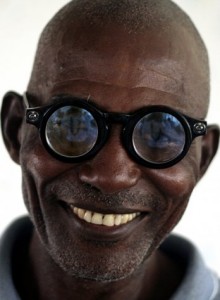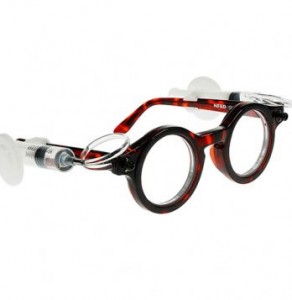We observe our environment through all of our senses. Right now, as I feel the keys on my keyboard fall under the pressure of my fingers, I also watch the screen as the letters appear in front of me. I can hear the faint noise of the cars passing outside, and taste the spearmint gum as it rolls against my tongue. The popcorn my roommate just made fills the air with its distinctive smell. For most of us, this scene I just described is nothing out of the ordinary. We are fortunate enough to have all five of our senses in good working order. Our brain processes all of this information in an instant, and we go about our normal activities without giving much thought to the complex tasks our body is effortlessly performing.
For many people throughout the world, one or more of their five senses is damaged, impaired, or simply does not work. One of the most common impairments is that of vision. Most of us that experience vision impairment see an optometrist and walk away with a new pair of glasses or contact lenses. However, for millions of people in this world that suffer from visual impairment, solving their problem is not so easy.
Let’s take a look at some statistics: About 1.3 billion people worldwide could benefit from corrective lenses. 90% of the world’s visually impaired live in developing countries.
Vision is one of the most valuable traits that we as humans possess. Poor sight can hinder our daily lives to an incredibly large extent. Some people have such poor  eyesight that they cannot drive, cannot work, and have serious issues when trying to complete simple tasks. For every 8,000 people in the developed world there is about one optometrist. In certain developing countries this statistic changes drastically. For example, in Mali there is one optometrist for every 8,000,000 people.
eyesight that they cannot drive, cannot work, and have serious issues when trying to complete simple tasks. For every 8,000 people in the developed world there is about one optometrist. In certain developing countries this statistic changes drastically. For example, in Mali there is one optometrist for every 8,000,000 people.
Luckily, this issue is gaining some awareness, and actions to combat the problem have begun. However, I believe that the current approach to publicizing the issue needs to be adjusted in order to secure more funding from the pubic. Joshua Silver is the inventor of the self-adjustable eyeglasses and the Director of the Centre for Vision in the Developing World (CVDW). These glasses allow for the wearer to adjust the lenses to the desired prescription without the help of an optometrist. The glasses utilize liquid pressure to control the focus of the lens. Fortunately, this design is relatively affordable and might just be the solution to the developing world’s vision problem.
Helping to eradicate the world’s eyesight problem are numerous organizations, but perhaps the two most eminent are Global Vision 2020 (GV2020) and the CVDW. Both of these organizations make use of Silver’s invention, and both make it their goal to have 1 billion people’s vision fixed by 2020. Both also recognize that the glasses need to be even more affordable, and that we need to find an effective way to distribute the glasses.
As of 2009, only 30,000 self-adjustable glasses had been distributed worldwide.  These organizations are helping to create distribution networks throughout the developing world in order to increase this number. Currently, a single pair of these glasses costs around $19. This might not seem like much, but to those living in developing countries, $19 can take weeks to earn. As far as reducing the costs of the glasses is concerned, Joshua Silver himself acknowledges that more research must be done. In order for more research to be accomplished, funding and donations are needed.
These organizations are helping to create distribution networks throughout the developing world in order to increase this number. Currently, a single pair of these glasses costs around $19. This might not seem like much, but to those living in developing countries, $19 can take weeks to earn. As far as reducing the costs of the glasses is concerned, Joshua Silver himself acknowledges that more research must be done. In order for more research to be accomplished, funding and donations are needed.
I agree with GV2020 and CVDW that more funding is needed. For this specific issue, money is paramount to solving the problem. I think the best potential source of funding is the general public. The public needs to not only be made aware that the issue exists, but also understand how important it really is. The current approach to publicizing the issue is inadequate.
Currently, most of these organizations emphasize the huge number of people in need of glasses. To me, they should instead focus more heavily on two closely intertwined issues that result from poor vision and the lack of glasses. First, highlight the serious problems that arise from having poor vision. For example, many people in the developing world are unable to work because of their poor eyesight. Second, make connections between these problems and other social issues. Organizations should show connections between eyesight and poverty, eyesight and hunger, eyesight and education, etc. Then, people will start to listen. Once the public realizes the importance of this issue, they will be more likely to donate money.
Luke Richner is a Program and Research Intern with the SISGI Group focused on global health issues, energy markets, and economic development. He is a senior at Duke University, completing his final semester.

